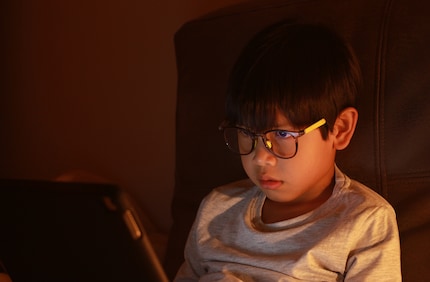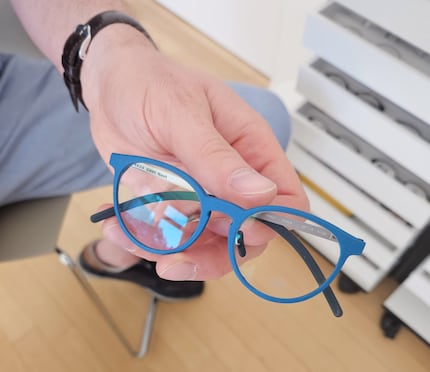
Background information
Help, so many children have braces!
by Martin Rupf

Shortsightedness is common in children. And while my son doesn’t actually suffer from the condition, he’s recently started wearing glasses. So why are so many other kids his age doing the same? Optician Thomas Frei explains.
Our ten-year-old son is a fairly keen reader, but he enjoys watching movies on his laptop or playing games on his tablet even more. A while back, we noticed that when he was doing any of those things, he’d hold the book, laptop or tablet pretty close to his face. When he then started complaining of the occasional headache, we decided it was high time to see an optician.
An examination revealed our son to be longsighted – an affliction rarely seen in children. Why is that atypical? Because most people with a visual disorder, including children, are shortsighted. The World Health Organization (WHO) estimates that five billion people will be shortsighted by 2050, corresponding to around half the world’s population.
Whether it’s shortsightedness or longsightedness, I feel like more and more children are wearing glasses these days. Like with braces, I’ve found myself wondering whether this means kids today really have worse eyesight, or whether their shortsightedness is simply being treated faster and more frequently.
To get to the bottom of it, I talk to Thomas Frei (44). A qualified optometrist, Frei took over Baden-based optometry practice Augenoptik Kuhn AG in 2021 – the same place he’d completed his optician’s training 25 years before.

Is it just me or are more and more children and teenagers these days wearing glasses?
Thomas Frei: No, it’s not just you. I’d estimate that around a third of children and adolescents in Switzerland have a visual disorder.
That’s a surprisingly high number.
It depends on what you’re comparing it to. In Asia, more than 80 per cent of all children and adolescents have a visual disorder.
I’m guessing that by «visual disorder», you mean shortsightedness. If the WHO forecast that around half the world’s population will be shortsighted within 30 years is anything to go by.
That’s right. Shortsightedness is the most common visual disorder in the world. And the WHO forecasts that billions of people will eventually be affected by it.
What’s causing this sharp increase in shortsightedness?
Some children basically inherit shortsightedness from their parents. If both parents are shortsighted, the chance that their children will also have the condition is well over 50 per cent.
But that alone wouldn’t explain the increase, would it?
No, it wouldn’t. Other potential causes could be a lack of daylight or, more importantly, the increased tendency towards looking at things close up – reading or using digital devices, for example. Unfortunately, digitalisation, increasing expectations placed on children in school and at home, and the intensive, close-up, indoor work that accompanies those things, mean the uptick in shortsightedness is showing no signs of stopping. This phenomenon is known as acquired myopia.
From your perspective as an optometrist, are you critical of digitalisation in schools?
Yes, If the circumstances allowed it, I’d go into schools and advise them on their approach to digital teaching materials. Crucial aspects of teaching with digital devices include the amount of time they’re in use, and at what distance they’re viewed from. Countries in Asia in particular are now beginning to take the problem seriously and address it. School buildings are increasingly being built with glass to allow more daylight into classrooms. In Taiwan, for example, schools have introduced significantly longer breaks so that children can spend more time outside in daylight.
As an optician and optometrist, aren’t you rubbing your hands with glee at the fact more and more people are becoming shortsighted? It’s good for business, right?
No, you’re wrong about that – or at least, taking a narrow-minded view of things. Our primary aim is to support people with visual defects and to help prevent shortsightedness from getting worse, especially in children and young people. After all, remember that impaired vision can also be associated with developmental disorders or have a negative impact on people’s everyday lives. It’s immensely rewarding when we opticians can help somebody live more productively, make their life better and ease their difficulty seeing. And there’s another crucial factor…
… Which is?
People with a power of minus 5 dioptres or below are more susceptible to developing eye conditions such as glaucoma, cataracts, retinal detachment or blindness as they get older. Since many billions of people will be affected by shortsightedness from 2050, we already know that helping them will be one of the greatest medical challenges of this century. It’s likely there’ll simply be too few ophthalmologists and eye clinics to treat everyone professionally.
Is there a way to promote healthy development of the eye?
Yes, you can make sure your kids are spending enough time outside and that they don’t start using electronic devices too early, for too long. Generally, it’s beneficial if they don’t spend too much time working on things from a short distance. I myself have three children, and none of them will be getting a mobile phone until they’re 12, precisely because I want to prevent them from becoming shortsighted.

What symptoms or behaviours might indicate that a child is experiencing problems with their vision?
There’s a myriad of things. One is holding books or tablets too close to their face. Constant rubbing of the eyes, sensitivity to light, frequent headaches or difficulty concentrating when reading can also be indicators.
As I came into your practice, I noticed an ad for a special pair of children’s glasses. What do they do exactly?
These glasses are equipped with relatively new, patented Miyosmart technology. It’s the first time lenses in glasses have been able to slow down or even halt the progress of shortsightedness in children and adolescents. We were one of the first opticians in Switzerland to offer glasses like these.
How does this technology work?
396 almost-invisible microlenses are arranged in a honeycomb pattern in the periphery of the lenses. The image the eye reproduces is then optimised, while preserving perfect long-distance vision. This can have a lasting positive effect on elongation of the eye, the primary cause of shortsightedness.
Are there specific and, more importantly, substantiated figures on this?
Yes. Glasses like these reduce the progression of shortsightedness by 60 per cent on average as the child’s eye is developing. This has been demonstrated in detailed studies and through our day-to-day work with children.
This is bound to come at a price, though. How much more do these glasses cost on average than conventional single-vision lenses?
Miyosmart lenses are custom lenses made specially for each child or young person. They’re about 2-3 times more expensive than standard glasses.
There are kids who simply don’t want to wear glasses. I’m guessing the fact that you’re also a child psychologist comes in handy there?
Absolutely. The way parents behave is the most important thing. If they have a dismissive attitude towards glasses and portray them in a negative way, the child won’t like them either. If, however, we manage to show the child that glasses are cool, they’ll be happy to wear them.
It probably helps that today’s glasses are nothing like the wire frames you’d get in the 80s and 90s.
True. In terms of aesthetics and design, children’s glasses in particular have undergone a huge development in recent decades. We ourselves sell beautiful, Swiss-made, 3D-printed models available in all kinds of colours.

If a child refuses to wear glasses, could contact lenses also be an option?
Yes, but given the high standards of hygiene they require, we generally only recommend contact lenses for people aged 16 and up. However, if a child has the right guidance and supervision, they can wear lenses at an earlier age.
What about laser surgery?
We advise against children having laser surgery because their eyes are still developing. It doesn’t make much sense to laser an eye that’s still growing, that hasn’t yet reached its full correction. As the eye is most stable between the ages of 30 and 40, we’d cautiously recommend having laser surgery then.
So, back to my son. Once it was clear that glasses might help him, the next step was to find the right pair. Yep, you read that right – they might help him. After all, his correction isn’t yet significant enough for glasses to be absolutely essential. Even so, we decided to get him a pair to help him read.
After we’d checked out a few stores, he decided (shock horror) on the most expensive ones. Knowing our health insurance would partly contribute towards the lenses (but unfortunately not the frame), we begrudgingly ended up buying his preferred pair. Ah, what we wouldn’t do for our children. To our great delight, however, he often wears them, is happy to do so and is even a little proud of them. Looks like we did everything right after all.
Header image: Martin Rupf
Half-Danish dad of two and third child of the family, mushroom picker, angler, dedicated public viewer and world champion of putting my foot in it.
Interesting facts about products, behind-the-scenes looks at manufacturers and deep-dives on interesting people.
Show all